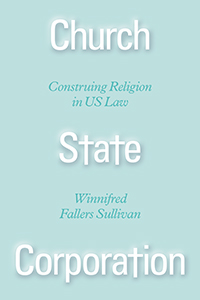The idea for this forum was sparked by a series of conversations that began online in late February 2020.
Winnifred Fallers Sullivan had sent me one of her characteristically short emails. It linked to the (then) latest New York Times article by Linda Greenhouse, a Pulitzer Prize-winning journalist who covered the Supreme Court for thirty years (1978-2008) and now writes a biweekly column for the Times. The article concerned Fox v. Washington, a case in which two male prisoners sued the Michigan Department of Corrections for refusing to recognize their “Christian Identity” religion, which allegedly demands white separatism of its adherents in residence, marriage, and worship. They lost their case in federal district court but won on appeal. The US Sixth Circuit Court of Appeals found that the district court judge, by weighing the prison’s interest in safety alongside whether the prison had substantially burdened the men’s religious exercise, had erred in its interpretation of the Religious Land Use and Institutionalized Persons Act. In other words, the district court arrived at its decision using the wrong legal standard. Greenhouse reads Fox v. Washington as a harbinger rather than an outlier: The Supreme Court, she suggests, has lent to the lower courts a model for accepting nearly any claim as dispositive of plaintiffs’ sincerity. “A moment of truth is approaching,” she concludes. “If we don’t want hate groups to have a seat in the prison chapel, the time to start drawing lines is now.”
A few days later, Sullivan sat to my left in the pews of Johnson Chapel. We were waiting for the novelist Jesmyn Ward to make her appearance at LitFest, an annual literary celebration at Amherst College. We revived our email exchange as we flipped through the program. “I wonder,” I thought out loud, “whether Greenhouse would have a conversation with you about your book for The Immanent Frame.” In many ways, the line drawing that Greenhouse seems to suggest will block white supremacists from weaponizing the free exercise clause to the US Constitution helped to create what Sullivan calls the “church-in-law”—the legal fiction of the church in US law. This fiction is the subject or antihero, we might say, of her new book, Church State Corporation. “The First Amendment,” Sullivan writes, “is understood to protect your right to be a church member and churches are recognized as having a right to exist and to enforce their own rules. This is a free country. You have a right to be foolish.” Less well understood is how to “[take] religion seriously without establishing it,” a project Sullivan undertakes by analyzing what she calls “the uncanny sovereign interchange” among church, state, and corporation across modern history from a phenomenological perspective. As Ward took the stage, Sullivan and I agreed that I would approach Greenhouse as a scholar, not a journalist.
Ward began by reading aloud the opening scene from her third novel Sing, Unburied, Sing. “I like to think I know what death is. I like to think that it’s something I could look at straight.” The speaker is Jojo, a biracial boy and one of the novel’s two thirteen-year-old protagonists. The other thirteen-year-old is Richie. He’s a ghost. Jojo’s Black grandfather, Pop, met Richie at the Mississippi State Penitentiary when he was forced to labor on the prison’s farm. Richie is not a figment of anyone’s imagination. He is an agent in the world, a character who acts in the present. “I think the goats understand each other . . . I think they know what that loose rope tied around the goat’s neck means.” Parchman Farm is where Black men and children as young as Richie were taken and re-enslaved to labor for the public sector and private industry in the 1930s and 1940s, following the criminalization of petty crimes throughout the South. It is also where they were tortured and killed. “That eye: still wet. Looking at me like I was the one who cut its neck, like I was the one bleeding it out, turning its whole face red with blood.” Ward spoke that evening, as she has discussed elsewhere, about conjuring up the ghosts of US history to tell the story of racial violence and trauma in this country.
Like Parchman Farm, Louisiana State Penitentiary at Angola is a former plantation and one of the most notorious maximum-security prisons in the United States. Angola, where prisoners are permitted to oversee their own churches, features in Chapter Four of Church State Corporation. Sullivan suggests that the “Black church-in-law” or “the body of Christ in blackface,” like the state and the corporation, is an elusive fiction that constrains the US legal imagination. The work of consolidating Black religion at Angola is mutually supported by faith-based programming and social scientific research on the rehabilitative effect of religion on prisoners, a confluence that sustains prison administration and its pro-social gospel. The churches at Angola are named in these accounts as the Angola Church, a figure that presumes historic continuity with Black religious practice under plantation slavery and yet willfully forgets the projects of whiteness and Christian civilization that such continuity entails. “Understanding the religiousness of mass incarceration,” Sullivan writes, “arguably lies not in a focus on the presence of christian ministers in prisons, whether they are liberal or conservative, but properly begins with the horror of black suffering across centuries.”
* * *
Book forums on The Immanent Frame typically consist of three components: an introduction by the featured book author, several responses by scholars representing the various fields with which the book engages, and the book author’s reply to these responses. This forum instead borrows its structure from the “Practices of relation” series inaugurated by former TIF editorial board member, Nancy Levene, and her colleague at Yale University, Noreen Khawaja. Following this introduction, five dialogues will be published in which Sullivan was paired with another scholar to discuss Church State Corporation. Her interlocutors are Leora Batnitzky (Religion, Princeton University), Samuel Moyn (History and Law, Yale University and Yale Law School), Nandini Chatterjee (History, University of Exeter), Linda Greenhouse (Yale Law School), and Julian Rivers (University of Bristol Law School). These conversations all took place over email between July-September 2020. Each pair of interlocutors decided the direction of the conversation.
The formatting decision for this forum was motivated by my sense of what Church State Corporation is about: convening as method, critique, and politics. Sullivan describes her method as a sociolegal phenomenology of religion, “speaking back theologically to law” through a “rabbinic reading” of First Amendment jurisprudence. She convenes literatures on the business of religion and the corporation; the history of slavery, whiteness, and British colonial rule across the Americas; and critical legal theory emergent from anthropology and gender studies. In the final chapters of the book, convening as politics becomes most evident. There, Sullivan fractures the legal interpretive mode of her analysis in earlier chapters to consider whether the church-in-law might be imagined otherwise. “The church-in-law’s persistence suggests that the religious collective is necessary, even valuable,” she writes, “but that the terms of its legal status are something to argue about, not to enforce.” She convenes in text and image a scene imagined by religion scholar Courtney Bender and illustrated by artist and religion scholar Kay Read and artist Rose Harding. In this scene the late Anthony Bourdain is a minister of a church. His congregants are Barack Obama and the parties to Masterpiece Cakeshop: Charlie Craig and David Mullins, the couple who sought a wedding cake to commemorate their union, and Jack Phillips, the baker who denied them service. Common conviction occasions their encounter in the church that Sullivan convenes, “a broader community that encompasses all three.”
* * *
Batnitzky begins the conversation with Sullivan by relating Church State Corporation to the works of Carl Schmitt, Karl Marx, and Ernst Kantorowicz, suggesting that Sullivan’s arguments “do nothing short of asking Americans and others to completely rethink the relationship between corporate bodies, law, and religion.” Church State Corporation, by exploring the US story that initially motivated Kantorowicz, challenges Schmitt’s singular sovereign as well as Marx’s understanding of religion as having been commodified by the modern state. Sullivan and Moyn invite into their dialogue Cécile Laborde, who in her recent defense of liberalism has argued that disaggregating religion allows political philosophers to “treat religious and nonreligious individuals and groups on the same terms, as expressions of ethical and social pluralism.” A question arises in this conversation about the role of religion in distributional politics—historic and contemporary—under a theory such as Laborde’s in which the state’s “metajurisdictional” authority is imagined as the only route to just accommodation.
Sullivan and Chatterjee pivot the forum to a discussion of the effects of British colonial disestablishment policies in the Americas and South Asia—across three centuries. Fragmentation emerges as a point of convergence between Sullivan and Chatterjee, who agree that by working close to the ground, seemingly localized practices reveal patterns about structure and system. In their dialogue, Sullivan and Greenhouse consider the trio of religion cases decided by the US Supreme Court at the close of its last term: Our Lady of Guadalupe School v. Morrissey-Berru, Espinoza v. Montana Department of Revenue, and Little Sisters of the Poor v. Pennsylvania. “When the Supreme Court privileges the complicity claims of employees who don’t share their bosses’ view of complicity in sin or of sin itself,” Greenhouse asks, “how is the Court understanding religion, let alone religion’s role in civil society?” To this Sullivan suggests that each of the three recent cases extends the reasoning in three earlier cases examined in the book (Hosanna Tabor, Trinity Church, and Hobby Lobby), and yet “the Court is only a symptom, not a cause” of the fractures in contemporary US civic life. In her book Sullivan suggests these fractures might best be mended through different imaginaries of collective life, ones not indebted to or that remake racial and statist patriarchies.
In his dialogue with Sullivan, Rivers discusses the paradox of disestablishment in the United States—the tendency among American judges to defend the rights of churches and yet refuse to engage in theological matters. Every legal system, they agree, establishes religion and thus, as Rivers highlights, “In some sense, every state is religious, distances itself from religions, collaborates with religions, constrains religions, and empowers religions.” When the conversation turns to the British context, Sullivan suggests that “[h]aving an established church—however attenuated—locates the issues in a helpful way . . . In the United States, lacking a church or a state, really, it is we, the people, who are in charge. All of our problems—including our inability to deal with the pandemic—sometimes seem to derive from our constitutional commitment to limited government and non-establishment.”
* * *
Many observers of US law and politics today no doubt locate their hope for the future of this country in the composition of our legal institutions. Church State Corporation suggests the future of our collective life lies elsewhere.














